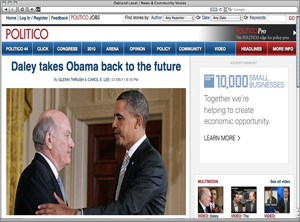Politico had in many ways dominated coverage of the midterms with its obsessive, feverish reporting, just as it had done two years earlier as Barack Obama beelined for the White House. Established in the lead-up to that presidential race, Politico has become such an ingrained part of national political coverage that it’s hard to believe it’s just four years old–was there ever a time when political fiends did not wake to the scattershot must-knows of Mike Allen’s “Playbook”?
But it was only back in January 2007 that founders Jim VandeHei and John Harris, formerly of The Washington Post, launched Politico, the upstart Beltway site and newspaper. They were backed by Robert Allbritton–then newly installed head of the Allbritton family, which owned network-affiliate stations–who had been preparing to launch his own Hill newspaper. Allen joined them from Time as they were preparing for kickoff.
The idea was to build exactly the multimedia outlet you see today: a splashy, revenue-earning newspaper and a must-click website thick with video reports and analysis; short and explosively written breaking news; morning-winning think pieces (often penned by Harris and VandeHei themselves); and, now, opinion columns by name pundits like Joe Scarborough and Michael Kinsley. Designed on their in-house CMS system, Papermate, the site is divided into verticals such as “video,” “policy,” and “2010.” And lest you should miss a minute of Washington’s action, you can click on Politico 44 for everything Obama, or Click, a gossipy section where you can learn that Gwyneth Paltrow is a distant cousin of Congresswoman Gabrielle Giffords, or watch highlights from the week’s Saturday Night Live.
What sets Politico apart is the outlet’s ethos. The model for its reporters is Allen, the relentless–and almost certainly sleepless–author of the morning “Playbook” sent between 5.30 am and 8.30 am, who is a kind of non-stop news-breaker (read Mark Leibovich’s infamous Times profile of Allen here). Politico‘s founders feel that’s the sort of person they need for the news cycle of today–one in which the web comes first. To that end, the site actively poaches star journalists who’ve proven they can thrive online, such as Ben Smith, who rose to prominence blogging about New York politics.
Back in 2008, Harris told CJR’s Clint Hendler that, in 2004, “People were not organizing their day around questions like what’s the morning lede, how do we freshen things up for the afternoon, what’s new on our blog. Jim VandeHei and I started Politico in part because we thought that it was important that newsrooms organize themselves around the web as a primary goal, rather than as a secondary goal around the print edition.”
It’s a profitable ethos, too, with Politico’s online prominence drawing advertisers and readers to the print publication, where rates are enviable. Overall, outlet’s revenue stream comes from print and online ads, and sponsorship of Politico events and special coverage. In February, more money will come with the launch of Politico Pro, a subscriber service for policy and political professionals that will focus on energy, health care, and technology–a subscription to one vertical will cost $2,495. And despite going for something different from the news cycle model promoted by legacy outlets, the Politico newsroom is large enough to resemble a legacy paper. Politico employs more than 130 editorial staffers (some working on the new project), and 50 on the business and technology end. There are also content-sharing arrangements with papers across the country, including in hot-button primary states, like New Hampshire’s Union Leader and Iowa’s Des Moines Register, which all bolster the brand.
What that brand is depends on how you look at it. For Harris, VandeHei, Allen, Smith, and others at Politico, their site and paper represents the next evolution of political journalism: frenetic, constant, insidery, well-reported, frequently-updated, and thrown at you in huge, sometimes scattershot, globs. For others, it’s just frenetic. In a Vanity Fair profile of Politico from mid-2009, Michael Wolff wrote: “It exalts, and fetishizes, in breathless, even orgiastic news flashes, the most boring subject in the world: the granular workings of government bureaucracy. It is, arguably, in its hyperbolic attentions and exertions, in its fixations on interests that could not possibly interest anyone but the person doing it and the writer writing about it, something like a constant parody of itself.”
It probably doesn’t matter what you think, though. Among a slew of struggling and failing startups, Politico is the one laughing all the way to the guy holding the tuna tray.
 WASHINGTON, DISTRICT OF COLUMBIA — On the night of the November 2010 midterms, as election results began trickling in, team Politico held a returns-watching gala at Washington, D.C.’s Newseum. It was the kind of lavish media event usually reserved for legacy media outlets–the Washington City Paper called the party “a throwback to the days when media companies actually made money… There were lamb chops, and
WASHINGTON, DISTRICT OF COLUMBIA — On the night of the November 2010 midterms, as election results began trickling in, team Politico held a returns-watching gala at Washington, D.C.’s Newseum. It was the kind of lavish media event usually reserved for legacy media outlets–the Washington City Paper called the party “a throwback to the days when media companies actually made money… There were lamb chops, and
